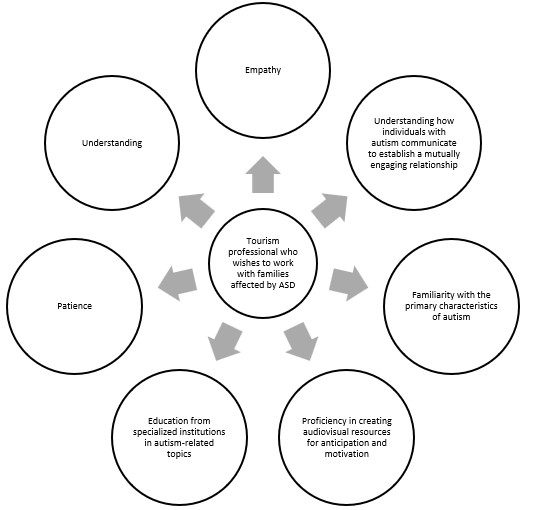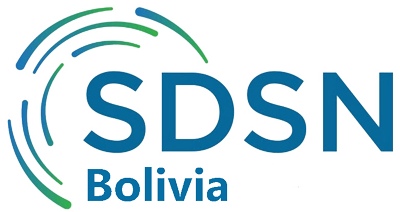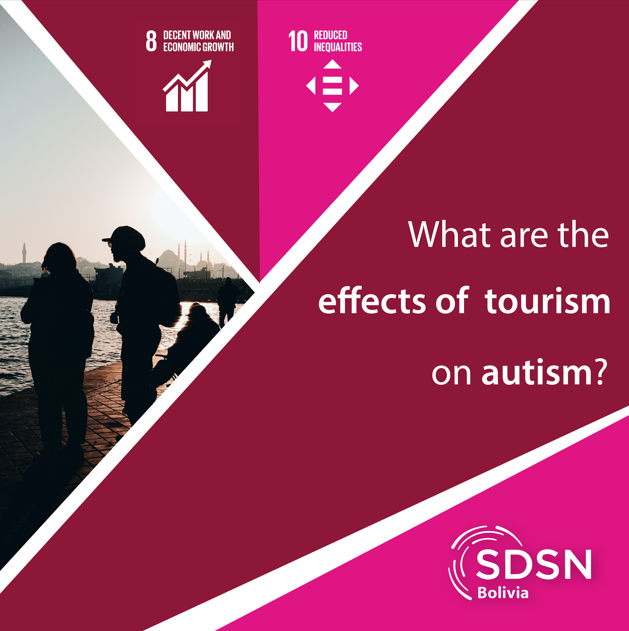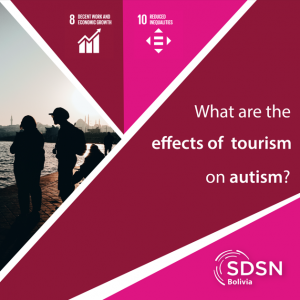November 3rd, 2023
The celebration of World Tourism Day in 2021 marked an unprecedented milestone when the World Tourism Organization (UNWTO) introduced the slogan “Accessible Tourism for an Inclusive Future.” This slogan was the result of a series of significant events, such as the Declaration on the Rights of Persons with Disabilities and the Convention on the Rights of Persons with Disabilities, led by the United Nations in 1975 and 2006, respectively. These events inspired and allowed UNWTO to join this cause.
Despite the progress in generating texts, guides, organizing conferences, and other efforts to promote inclusive tourism worldwide, Latin America is still in the process of incorporating inclusive services and aspects into its tourism value chain. One of the most crucial challenges in this regard is the specialization of tourism activities that cater to different types of disabilities, with intellectual disabilities presenting the greatest need and obstacles.
In this context, this research focused on identifying the potential effects of tourism on individuals with autism and their families. According to the Autism Confederation of Spain[1], autism spectrum disorder (ASD) is a neurobiological condition that affects the configuration of the nervous system and brain functioning, characterized by:
- Specificity: The core characteristics of ASD are specific.
- Variability: No two individuals with ASD are the same.
- Invisible Disability: ASD is not identified by any differentiating physical traits.
- Families: ASD impacts all individuals close to the affected person. (Autism Confederation of Spain, n.d.)
This disorder is lifelong, meaning there is no cure, and although each case is different, ASD primarily affects two dimensions of individual functioning: communication and social interaction and flexibility in behavior and thought.
Regarding the variable of the tourist experience, it can be conceptually defined as “the creation of value at each stage of the journey, from the conception of the visit idea to the return to one’s usual environment, generating emotional and meaningful effects for those who live it.” (Ministry of Foreign Trade and Tourism of Peru, 2018:21).
Therefore, information was collected on how a tourist experience can affect individuals with autism and their non-autistic family members. For this purpose, interviews were conducted with experts in inclusive tourism and autism to identify the dimensions and components of autism in the psychosocial context and their relationship with a tourist experience. Additionally, a questionnaire based on an Empathy Map was created and applied to families with autism in La Paz, Cochabamba, and Santa Cruz who had at least one tourist experience. This allowed for a comprehensive analysis of the effects before, during, and after the tourist experience on the psychosocial behavior of these families.
Psychosocial Behavior of a Family with Autism Before a Tourist Experience.
Experts agree on the importance of preparing individuals with autism before a tourist experience. In this regard, the ConectaTEA[2] Foundation and the Autism Confederation of Spain[3] use pictograms to describe the travel itinerary and understand its positive and negative aspects. However, today, technology allows for the creation of personalized pictograms through platforms such as those used by the Orange Foundation[4] or applications that include audios and videos to explain the travel program.
ConectaTEA, for example, organizes activities such as fairs, walks, and meetings that involve the relatives of individuals with ASD. It is crucial that these family members act as information facilitators and motivate their loved ones with autism to participate in new activities outside their comfort zone. The methodology of this organization involves an honest narrative that addresses both the negative and positive aspects of any tourist experience.
In addition to presenting the travel itinerary, Autism Spain provides a journal in which individuals with autism can express their emotions regarding the idea of traveling to a new and unknown place. This journal also includes a space for them to suggest activities they would like to do or places they would like to visit.
In the city of Santa Cruz, Bolivia, there is the Municipal Therapeutic Center, a facility that offers hydrotherapy and sports activities for individuals with autism. These activities are essential for improving flexibility, developing psychomotor skills, and promoting social relationships through team sports. It has also been identified that these activities significantly contribute to mentally, sensory, and physically preparing individuals with autism to travel and enjoy positive experiences in new destinations.
In the city of La Paz, the Foundation for the Integration of People with Autism (FIPA) has a Sensory Room. This space recreates various sensory situations, some of which have included markets, parks, theaters, or concerts, exposing individuals to a variety of sensory stimuli. This becomes a fundamental tool to safely familiarize individuals with autism with new places and situations.
On the other hand, family members who accompany individuals with autism should also prepare for the trip. Although they do not use the same tools mentioned earlier, experts suggest that the accompanying person, usually a parent, should be familiar with the itinerary in advance. This allows them to provide their input and contribute from their experience to adapt and enrich the activities, ensuring an inclusive and enjoyable tourist experience for all involved.
Based on the paragraphs above, there is no single way to prepare a family traveling with a member with autism. What is essential to involve all family members in creating a tool that offers the opportunity to prepare individuals in advance for the trip. This ensures a genuine understanding of what it means to travel to a new place for someone with autism.
The interviewed families support what has been mentioned, indicating that they have used various innovative methods to prepare their family members with autism to be ready, understand, and embrace the idea of traveling. Some of these methods include creating videos simulating the trip with models and toys, as well as showing videos and stories of other families with autism who have enjoyed tourist experiences.
It is important to note that the psychosocial behavior of an individual with autism before a trip will largely depend on how they process the idea of traveling. This preparation is crucial for families with autism, as it can transform a stressful environment into a relaxing one and change anxiety into curiosity. This allows the tourist experience to be a catalyst for flexibility, spontaneous expression, and social relationships.
Psychosocial Behavior of a Family with Autism During the Trip
Experts from Spain, Belgium, and Mexico agree that families experience a surge of emotions, both positive, such as joy, curiosity, and interest, as well as negative emotions, like stress, anxiety, uncertainty, and concern when the day of embarking on the tourist experience arrives. It is essential to channel these emotions, minimizing the negative ones and fostering the positive ones. The active participation of non-autistic family members plays a vital role in conveying an optimistic behavior that inspires confidence and enthusiasm in the individual with autism to enjoy the tourist experience. Many of the interviewed families, especially those from La Paz, agree that for a first trip, it is advisable to choose nearby destinations and minimize transportation time since this initial stretch can be crucial for a smooth start to the tourist experience. Prolonging the stay of an individual with autism in a vehicle can cause stress and anxiety, potentially leading to an autistic crisis.
To reduce anxiety and stress during the trip, experts from the Autism Confederation of Spain suggest carrying out sensory and mental stimulation activities. For this purpose, they use a “relaxation kit” tailored to the needs of traveling families, including items such as noise-canceling headphones, stuffed animals, and drawings.
Once families arrive at their destination, it is recommended to have a brief informative meeting about the planned activities during the tourist experience. This will provide information about tourist attractions, activities, the estimated duration of each activity, and the rules for scheduled visits, ensuring security for families.
Cuisine is also an essential factor during the tourist experience. Often, families prefer to bring the food that their loved ones with autism regularly consume to avoid autistic crises triggered by unfamiliar foods. However, experts recommend coordinating with the families to adapt the menu by introducing new ingredients and foods that may be well received, with the goal of expanding gastronomic tastes.
It is essential to recognize that although activities are carefully planned, unexpected situations may arise during visits. Sometimes, activities intended to promote social relationships may not succeed, and individuals with autism may show disinterest in meeting new people. Autistic blockages that affect the enjoyment of the trip can also occur. Therefore, having a risk control plan to address these situations is necessary.
Psychosocial Behavior of a Family with Autism After the Trip
For the final stage of the tourist experience, it is necessary to wait for a certain time to understand the effects on the behavior of families with autism. On the surface, it was possible to analyze through interviews with families that returning to their daily lives did not represent significant difficulty. However, there were some testimonies, mainly from families in Santa Cruz, indicating difficulties in returning home, as family members with autism somehow grew fond of the place or a particular attraction, making it difficult for them to understand that this experience had ended.
To avoid these adversities that could lead to the aforementioned crises or autistic blockages, the interviewed experts recommend creating specialized souvenirs to serve as mementos of the tourist experience, providing tangible items to families. These souvenirs should reflect the most valuable aspects of the trip, from a family photo to a replica of the most important attraction visited.
The following table is the result of a post-tourist experience analysis conducted with interviewed families from La Paz, Cochabamba, and Santa Cruz, who primarily traveled to natural destinations. This table is divided into two parts since it was essential to analyze the effects of the experience on individuals with autism on one side and their non-autistic family members on the other.
Table 1: Effects of a Tourist Experience on Families with ASD
|
INDIVIDUAL WITH AUTISM |
NON-AUTISTIC FAMILY MEMBER |
|
Restrictive interests: Tourism can motivate them to engage in new activities beyond their comfort zone, achieving greater flexibility. Anxiety, stress, or excessive worry: Tourism creates spaces for relaxation and peace, reducing signs of anxiety or stress to a minimum. Absence of social relationships: Tourism allows for experiences in new spaces, encouraging more social behavior. Restrictive communication: Tourism can improve language skills by interacting with other people, talking to other children. Tourism enhances the proximal development area, allowing them to engage in imitation and learning actions, motivating the development of communication skills. Delay in motor skills: Tourism allows them to explore new paths, engage in physical activities where they have a sense of freedom, and can do what they feel and want without repression, supporting gross motor skills, enabling sensory organization as individuals. Low self-esteem: Traveling to new places and engaging in tourist activities such as trekking, biking, hiking, etc., independently, boosts self-esteem levels. Unusual eating habits: Tourism allows them to experience new gastronomic alternatives typical of the visited place.
|
Anxiety, stress, or excessive worry: Planning a tourist trip inhibits stress or anxiety generated by the uncertainty of being in new places. Fear of interacting with other people: Tourism allows them to meet not only new places but also new people who can help overcome the fear of social interactions. Health and Wellbeing: The stress generated by autism is reflected in a decline in mental and physical health. Tourism is an opportunity for parents to allow their children to travel by themselves and dedicate time to themselves. Distrust of new psychosocial development methods: Through tourism, greater flexibility and interest in performing and experiencing new activities in entirely new spaces can be promoted. |
Source: Self-Development
Knowledge and Skills of a Tourism Professional to Work with Families with ASD
The research also provided significant findings about the identification of essential knowledge and skills that must be applied by professionals in any sector of tourism when interacting with families that have members with autism. These aspects are detailed in the following chart.
Figure 1: A tourism professional who wishes to work with families affected by Autism Spectrum Disorder (ASD)

Source: Self-Development
While the knowledge and skills highlighted in the chart are applicable in most tourism sectors, it is essential to delve into some aspects and consider others according to the specialty of each tourism professional. Currently, there is a lack of training in tourism sectors on how to provide adequate service to people with disabilities, particularly those with intellectual disabilities.
To address this gap, it is suggested to create customer service guides and manuals for autism based on this information. These resources can be physical or audiovisual and are intended to help tourism companies offer more satisfying experiences. This, in turn, will have a more positive than negative impact on the psychosocial behavior of individuals with autism, facilitating their full integration into society.
Conclusions
It is crucial to conduct further research on the effects of tourism on individuals with autism, encompassing not only their psychosocial dimension but also their economic, academic, and occupational impact. Only through such research can solid proposals be developed to highlight the importance and impact of tourism in the context of autism. This will enable the integration of tourist activities into social, educational, and economic programs that work with families with autism in the country.
Families with autism recommend tourist destinations that have well-trained staff and adequate infrastructure to ensure a pleasurable experience. On the other hand, experts from Bolivia, Spain, and Belgium suggest that trips to natural destinations are ideal. These destinations offer tourist attractions with a high sensory level, which can have a positive impact on the behavior of families with ASD. In these places, a variety of activities can be carried out, such as:
- Trekking on interpretive trails based on native flora and fauna.
- Participating in yoga or other relaxation and physical and mental improvement activities.
- Tasting new menus based on natural products.
- Enhancing the sense of hearing by identifying and memorizing new sounds of birds, insects, animals, water sources, etc.
- Enhancing the sense of smell by smelling the different floral species and aromas of the natural environment.
- Enhancing the sense of touch by coming into contact with new textures such as soil, tree trunks, leaves, flowers, animals, etc.
- Reducing anxiety by immersing oneself in bodies of water such as lagoons, rivers, natural springs, pits, etc.
- Introducing new interests related to the conservation of natural resources, creating herbariums, entomology, etc.
It is relevant to highlight the participation of women throughout this research. In most cases, the individuals who lead and are part of organizations related to autism are women. Likewise, in most of the interviews conducted in La Paz, Cochabamba, and Santa Cruz, the interviewees were women, as they often play a central role in the lives of individuals with autism. This fact is significant, especially considering the widespread presence of women in the tourism sector in Bolivia.
Footnotes
[1] Confederación de Autismo España (s.f.). ¿Qué es el autismo? https://autismo.org.es/nosotros/quienes somos/
[2] ConecTEA es una organización dedicada a promover el turismo inclusivo para personas con autismo en España. Ofrecen una variedad de actividades y servicios diseñados específicamente para satisfacer las necesidades de este grupo. https://www.fundacionconectea.org/
[3] https://www.autismo.org.es/ . Esta organización ofrece recursos, programas de apoyo y promueve la concienciación sobre el autismo en España.
[4] Fundación Orange desarrolla soluciones tecnológicas para mejorar la calidad de vida de las personas con TEA. https://fundacionorange.es/junto-al-autismo/soluciones-tecnologicas/
Bibliography
Confederación Autismo España (2023) “Qué es el Autismo.” https://autismo.org.es/el-autismo/que-es-el-autismo/
Fundación Orange (2019) “Campaña #JuntoalAutismo.” https://fundacionorange.es/junto-al-autismo/campana-juntoalautismo/
Ministerio De Comercio Exterior Del Perú (MINCETUR) (2020) “Guía para el diseño de experiencias turísticas.” Ministerio de Comercio Exterior. Perú. Pages 1-47. Available at: www.mincetur.gob.pe
Organización Mundial De Turismo (OMT, 2021) “Turismo para todos – la OMT presenta el Compendio de Buenas Prácticas. Accesibilidad y Desarrollo del Turismo Inclusivo” OMT All Regions. https://www.unwto.org/es/news/turismo-para-todos-la-omt-presenta-el-compendio-de-buenas-practicas-accesibilidad-y-desarrollo-del-turismo-inclusivo
Morales, Páramo. et al. (2020) “Métodos de investigación cualitativa: fundamentos y aplicaciones.” 1st Edition. Universidad del Magdalena, Santa Marta – Colombia.

 Español
Español

